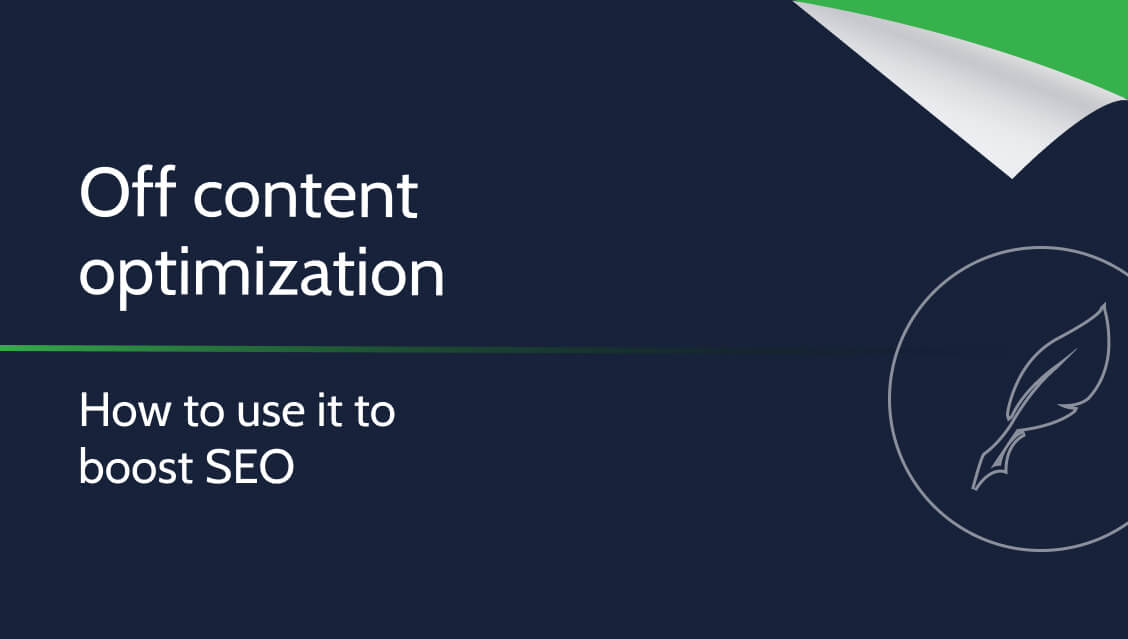Off content optimization – how to use it to boost SEO?

Blog post are supposed to be concise and clear so as to be in line with SEO rules. It’s also very important for blog contents to be of high quality so that it can compete for top positions in Google and other search engines. But as we often advise, its good practice to support good contents in a number of ways to further boost performance. One of such ways is search engines optimization. In this article, we will discuss about what additional tweaks we can incorporate with good contents in order to improve SEO results.
Blog articles and other SEO content – features
Search engines are programmed to show comprehensive contents that best answer users’ queries. Keywords, domain credibility and thousands of other factors make up a search engine’s algorithm for returning answers. So, writing text for SEO can be summarized thus: Search engines value quality and detest trickery and fraud; therefore contents that want to rank very well in search engines must therefore be of high quality specifically created for users who are hungry for knowledge.
The text must be focused on the users, not search engines.
There is one thing that we are supposed to take note of; if we don’t make our content great and valuable from the beginning, then it’s of no use doing any kind of optimization. This is why we are supposed to write the text to benefit the reader, and not just for search engines. We are supposed to put enough information that will help the search engines algorithm to index our content well, but this is not complete if the write-up does not contain interesting information and writing style.
For this aspect, the measure is the average time spent on the page (a high score indicates the attractiveness and clarity of the presented text). Specialized content is the main deal and SEO optimization is just a small cherry on top.
Optimization beyond content – what is it?
Optimization beyond content (also known as Off-content optimization) is the execution of tasks that will further increase the visibility of your content on the web.
What comes next after we’ve already created a fantastic article? Optimization, of course! The modifications we will make after creating great content have impact on positioning as well as user comfort and acceptance by Google and other search engines’ algorithms.
We will solely cover onsite positioning (inside the website itself) in the topics that follow. This can be done by you using a content management system (CMS).
We can properly optimize texts for SEO on each CMS, whether we run a blog on WordPress or an online store on SkyShop or PrestaShop.
‘Read more’ tag
This is a fantastic strategy to promote a website’s home page. By beginning each article with the major keyword phrases, the call to “Read more” becomes an arbitrary act that combines both functionality and good presentation.
Featured photo
One of those elements that, while not essential to SEO, can nonetheless be beneficial is featured photo.
The attractiveness and aesthetic appeal of websites are improved by including photographs in the articles, which raises the number of visits. Additional alt text setup will enable visibility in search engine’s “image” section
Photo in the article
Having at least one image in the article’s center is advisable. Once more, by phrasing the alt text, we can compete for exposure in Google Images. A excellent visual element that the reader will not miss is a topical photo that is relevant to the content.
Meta-descriptions
The contents in the search results are what we input in the meta-descriptions and meta-title. They are a crucial component because they entice you to visit the website, which results in better positioning. The search engine will automatically fill in the blank fields with the information from the article in the absence of settings.
Since they compete with one another to catch the attention of search engine users, it is worthwhile to use the ability to alter meta-descriptions and organize them in a way that encourages visitors to enter the site.
Tags
Search engines use tags, but only when such tags are truly helpful. It is simpler for the user to traverse a website and find interesting content when tags are placed appropriately.
It is important to think about the right tags because of this. Several hundred “quickly invented” ones won’t be as beneficial as a few accurate ones.
Categories
Similar to tags, properly sorted categories make it easier for readers to find the intriguing information they’re looking for. Once more, the idea that content should be approached strategically rather than randomly applies here.
Links
A further helpful component for the user is properly implemented internal linking, which makes it simpler for them to navigate between interesting material. This process has an impact on positioning as well, making the website more visible.
Due to the use of extensive internal linking, Wikipedia has made it much simpler to locate relevant content.
Headlines
This is a crucial yet frequently ignored subject. Headings provide information about the text’s hierarchical organization to both readers and search engines.
They are available in the Heading 1 through Heading 6 (H1-H6) range. H1 is the heading, H2 are the main points, H3 are the details of the points, H4 are the progression of the details of the points, etc. In other words, inferiors talk about superiors. The right heading hierarchy helps with readability and tells search engines which keywords are more crucial than others.
Paragraphing
Blocks of text that are too long make readers tired, so avoid them. It’s simple to improve your article’s clarity and clarity by separating your content. It is ideal to use paragraphs every 2-4 phrases, depending on the circumstance. In order to distinguish between different lines of thought, it is important to keep the logical flow of phrases. This gives us the “reading like a string” effect, which heightens the attractive form of articles. Enter (without the Shift key) should be used to distinctly divide each paragraph from the next.
Bold important parts
Users and search engines are informed via bold lettering which word is particularly crucial. This is a fantastic technique to make your material more readable by highlighting its most crucial components.
Let’s now summarize everything discussed above into a clear infographic:

Optimization beyond content - FAQ
Definitely yes – it takes a small amount of time, but significantly translates into the results obtained.
When properly done, optimization outside the content increases the readability of the text, which translates into a positive reception of the article and higher positions in search engines.
In the article above, we discussed good optimization practices, but there are also bad ones, although it is more accurate to use the term “outdated”. These include bolding only keywords (which makes bolding lose its distinguishing function) and justifying text (which spreads words and creates irregular spaces between them when readers view the text on devices with different resolutions).
Summary
- Off-content optimization is minor changes within the text that affect the visual and functional aspect.
- Although the information contained in the article is the decisive factor, additional optimization is always advisable to increase the results obtained.
- Off-content optimization is best done directly in the CMS system. This ensures that the text is refined as much as possible (not everything can be done in the text file itself).

















Leave a Reply